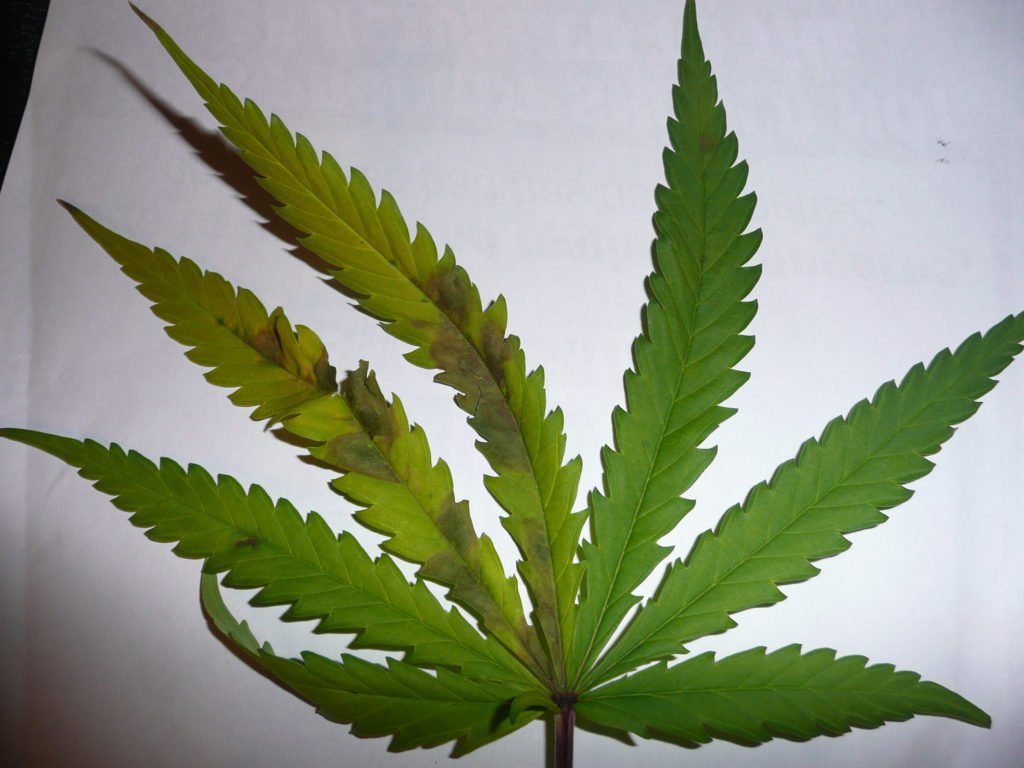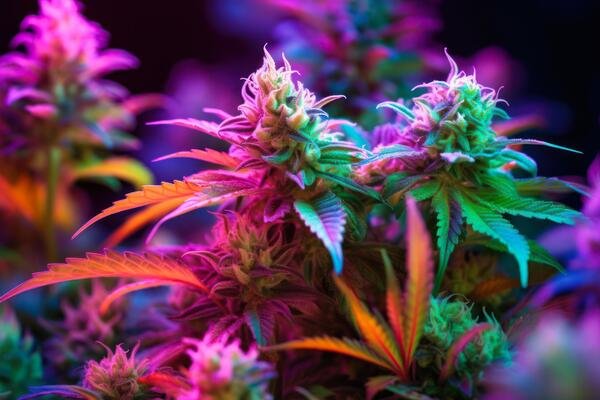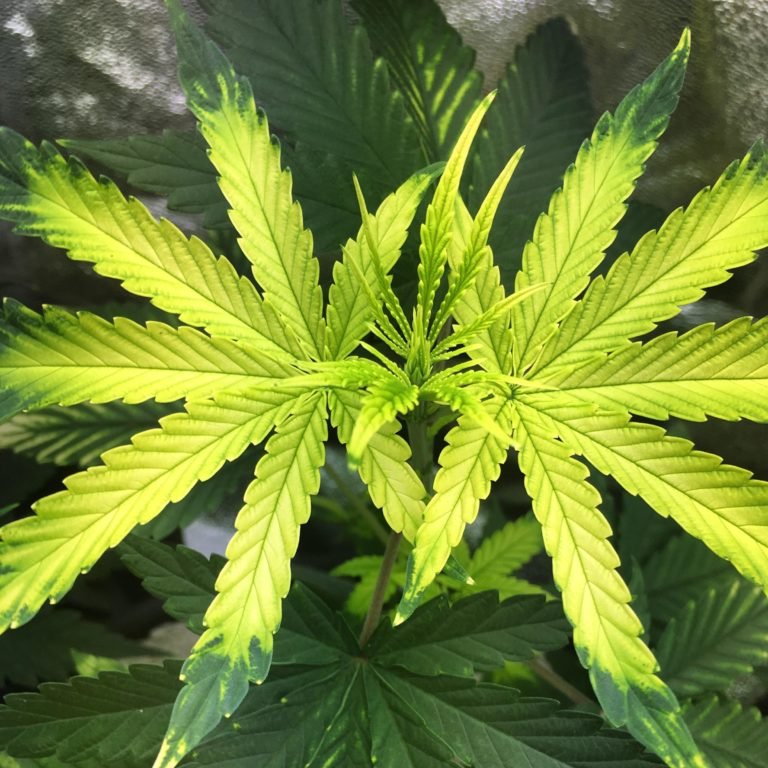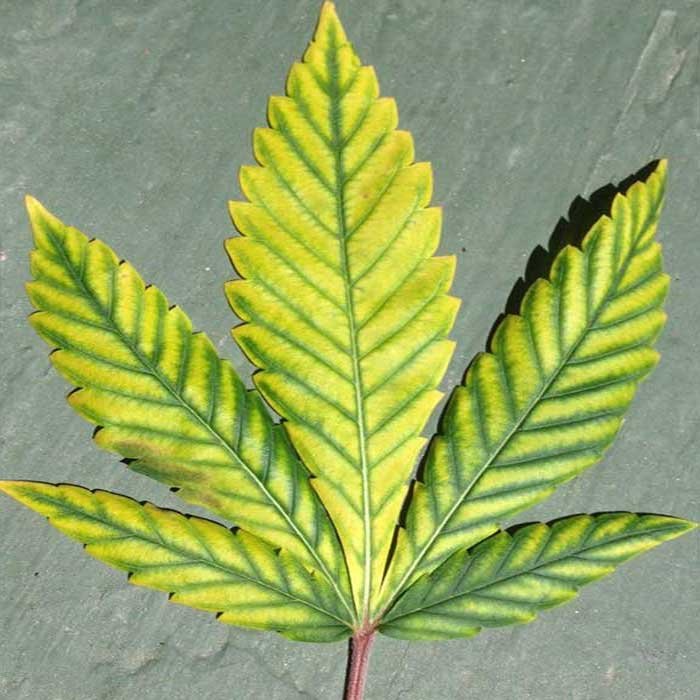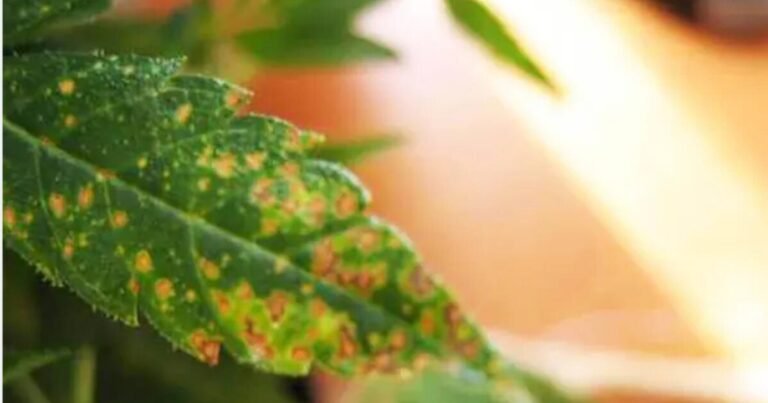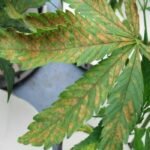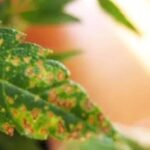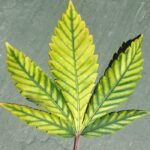Micronutrients play an important role in the plant. These tiny and powerful substances which include minerals like Boron, Zinc (Zn), Sulfur (S), and Manganese are essential for numerous metabolic processes and vital functions in cannabis plants.
S deficiency in cannabis plant
S deficiency closely resembles Nitrogen (N) deficiency in its early stages causing the entire leaf become pale and chlorotic with slightly darker veins. However, S deficiency typically affects the newest and youngest leaves first while in N deficiency the opposite occurs. Furthermore, Sulfur deficiency first affects the underside of the leaf before progressing to the tip, which also differentiates it from many other deficiencies.
As the deficiency progresses, the tips and edges of leaves may begin to turn brown and dry out. This effect is usually much more subtle than with other deficiencies that cause the same symptom. In the later stages, the entire leaf takes on a yellowish-white appearance, and older leaves begin to droop.
How to solve Sulfur deficiency
S deficiencies are very rare but they usually can be corrected.
Depending on the severity, fertilizers rich in Sulfur can be used. Some examples are:
- Ammonium Sulfate, which provides 24% of S.
- Magnesium Sulfate, which provides 22% of S.
- Potassium Sulfate, which provides up to 22% of S.
- Calcium Sulfate, which provides up to 18% of S.
If horse poop is avaible, applying layers of it to the garden soil is also an option that wil consistently provide S to the plant.

Mn deficiency in cannabis plants

Mn deficiency is also rare and shares several similarities with S deficiency. In the early stages, leaves begin to turn yellow at the base of the leaf before spreading towards the tip, leaving slightly darker veins. As the deficiency progresses, brown necrotic spots begin to appear throughout the leaves. These spots will spread throughout the plant if the micronutrient level is not corrected.
How to fix Manganese deficiency
If the deficiency is detected early usually can be corrected by flushing the roots with a pH of 6 and adding a light nutrient solution with the same pH. It’s also a good idea to ensure there isn’t an excess of iIon (Fe), as this can difficult Mn absorption. If the deficiency doesn’t disappear in about a week, consider using a Mn chelate.
Unfortunately, if a deficiency reappears during flowering, serious pruning is required to remove the affected areas. Just remember not to do it all at once, because cutting off all those leaves at once can severely stress the plants.
Zn excess and deficiency in cannabis

Zn is a necessary element for marijuana plants because it directly interacts with the creation of chlorophyll and is also directly related to the production of auxins and growth hormones. It should be noted that Zn assimilation depends on the pH of the substrate and the phosphate concentration of other nutrients, as in the case of excess Phosphorus (P).
Zn is absorbed by plants in the form of the bivalent ion (Zn2+), and is also easily absorbed from the epidermis and branches.
Detection/Solution:
- Zn deficiency is detected by observing the appearance of chlorosis in the plant’s youngest leaves. Burning appears on the edges of the leaves, and the plants experience very slow growth.
- Abnormalities are found in leaf development, with leaf elongation and a reduction in internodal spacing, while the leaves tend to form rosettes.
- To adress this deficiency, a root drench should be applied and fertilizers rich in rapidly absorbed macro- and micronutrients should be used.
- If the deficiency is advanced, a Zn mononutrient can be sprayed on the leaves for greater plant assimilation.
- An excess of Zn causes rapid plant death due to its high toxicity. Iron (Fe) deficiencies can also be caused by an excess of Zinc.
Solution to Zn excess: The solution to excess Zn is to perform a root wash with a stable pH along with a salt breaker to help clean the substrate. Then, make a light and complete fertilizer with macro and micro elements.
B excess and deficiency in cannabis

Boron is a necessary nutrient for the development of many of the physiological functions of cannabis plants, such as cell wall formation. It is an element that has a very difficult time moving through the plant, so its deficiencies will be detectable in the youngest shoots. However, it should be noted that when the plant absorbs it well, the youngest parts have twice the amount of this element as the oldest leaves.
B will be absorbable by the plant with a stable pH of 5.0 to 7.0 and will help maintain the stability of other elements, preventing Calcium deficiencies, and will also contribute to the modification of some hormonal processes, such as flowering and fruiting of buds. The ovaries of female flowers widen their ducts, facilitating the entry of pollen for better fertilization and seed production.
The excess of other nutrients, such as N, will cause a Boron blockage, which will be a clear deficiency of this element even if the elementis in the substrate, since the micronutrient will not be available to the plants.
Detection/Solution:
- Abnorrmal growth of plant tips; roots swell and stop growing. Burns appear on plant leaves, which can be confused with typical burns caused by heat radiation from the light source or the sun itself. Necrosis develops between the veins; the roots become soft, facilitating the growth of fungi. The leaves thicken, becoming droopy with chlorosis and necrosis.
- A high concentration of Calcium produces calcium borates that are poorly soluble in plants.
- Organic matter excess causes B to be retained in complex forms that release the nutrient very slowly.
- With abundant watering and sandy substrates, a deficiency can occur due to the ease with which Boron is leached from the substrate.
- In cases of severe drought, the elements rise to the substrate by capillary action, making B inaccessible to the roots.
- To treat B deficiency, give plants a tablespoon of boric acid per 4 liters of water or water with chelated fertilizers rich in B.
- Excess boron is detected visually through yellowing of the leaves. The edges of the leaves become necrotic towards the center of the leaf. Some insecticides may contain high concentrations of boric acid, so avoid contact with the substrate.
Solution for B excess: To solve the excess, a root flush should be performed with a pH stable at 6.0.
Cu deficiency in cannabis
Cu is a critical micronutrient for cannabis plant development because it participates in various electron transfer reactions and enzymatic activities. It plays a crucial role in the synthesis of Lignin, a structural component of plant cell walls, and contributes to reproductive processes.
Without sufficient Copper, plant growth, root development, and overall health may be impaired.
Signs of Cu Deficiency and Corrective Measures
A deficiency in this micronutrient causes the following symptoms:
- Leaf chlorosis with blue-green hues
- Crooked or distorted leaf growth.
- Delayed flowering and reduced fruiting
- Weak and brittle stems.
Providing adequate copper is key to restoring vibrant green leaves and ensuring plants thrive.

Molybdenum (Mo) deficiency in cannabis
Mo helps to transform Nitrogen (N) into a usable form in cannabis plants, facilitating its fixation. It is an essential component of Nitrogenase, the Nitrogen fixation enzyme in legumes.
By facilitating N metabolism, Molybdenum ensures that cannabis plants have access to this vital component for growth and development.
Identifying Mo Deficiencies in Cannabis
If Mo is scarce, plants will not reach their full potential. These are signs of a deficiency in this micronutrient:
- Yellowing or chlorosis betwen the veins of the leaves.
- Stunted growth and reduced vigor.
- Abnormal leaf development.
- Poor flower and seed formation.

Nickel (Ni) deficiency in cannabis
Ni ensures that the metabolic processes of cannabis plants function properly. It plays a crucial role in enzyme synthesis, nutrient uptake, and Nitrogen (N) metabolism.
Without sufficient Nickel, plant growth and development will be impaired, stunting growth and potentially affecting the plant’s overall health.
Symptoms of Ni deficiency
These are the signs of this micronutrient deficiency:
- Interveinal chlorosis with burnt tips.
- Reduced leaf size and distorted growth.
- Delayed flowering and poor seed production.
- Abnormal root development.
Symptoms of Ni-deficiency are similar to those of N-deficiency. The lower leaves show chlorosis with necrotic tips, and growth is inhibited.

Chlorine (Cl) deficiency in cannabis
Cl ensures that cannabis plant cells maintain proper turgor pressure. It influences osmosis, stomatal regulation, and contributes to photosynthesis.
By maintaining the delicate balance of water and nutrients within your plants, Chlorine contributes to their overall health and productivity.
Signs of Cl Deficiency in Cannabis
When Chlorine levels drop, cannabis plants may become slightly dry. Some symptoms of Cl deficiency include:
- Wilted leaves and leaf necrosis.
- Reduced growth and overall vigor.
- Poor flowering and yield.
- Increased susceptibility to disease and stress.

Cobalt (Co) deficiency in cannabis
Cobalt is a component of vitamin B12, which is necessary for the activity of N-fixing bacteria, so Co is essential for Nitrogen fixation.
By enabling N fixation, Co contributes to Nitrogen metabolism and overall plant growth.
Co deficiency and its effects in cannabis plants
When Co levels are low, these are the signs of deficiency:
- Stunted growth and reduced vigor.
- Interveinal chlorisus and leaf necrosis.
- Delayed flowering and poor seed production.
- Abnormal root development.
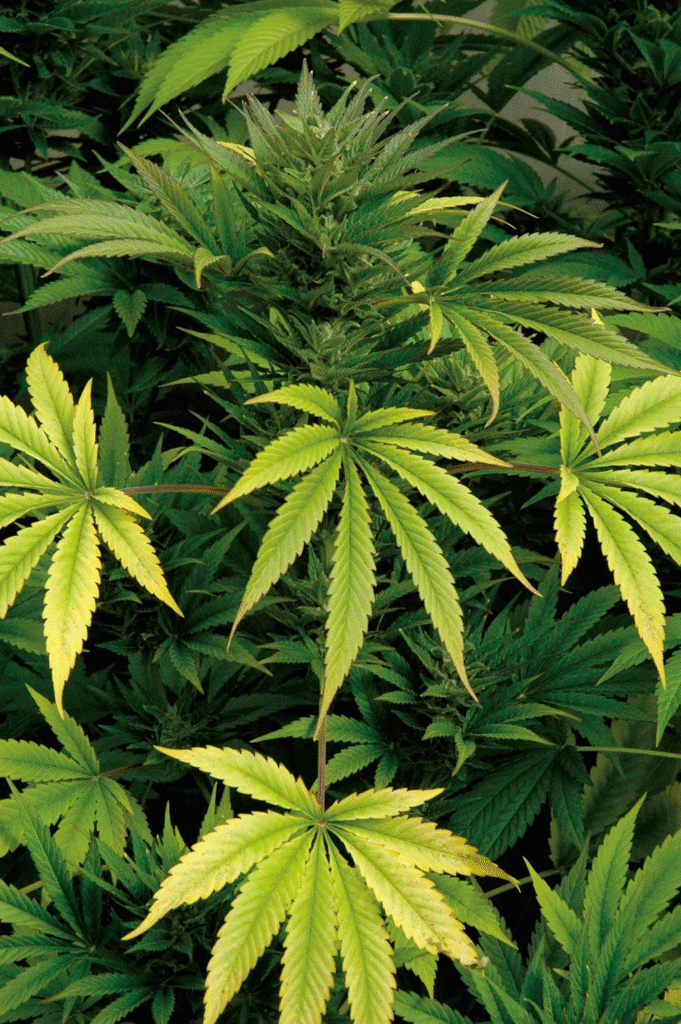
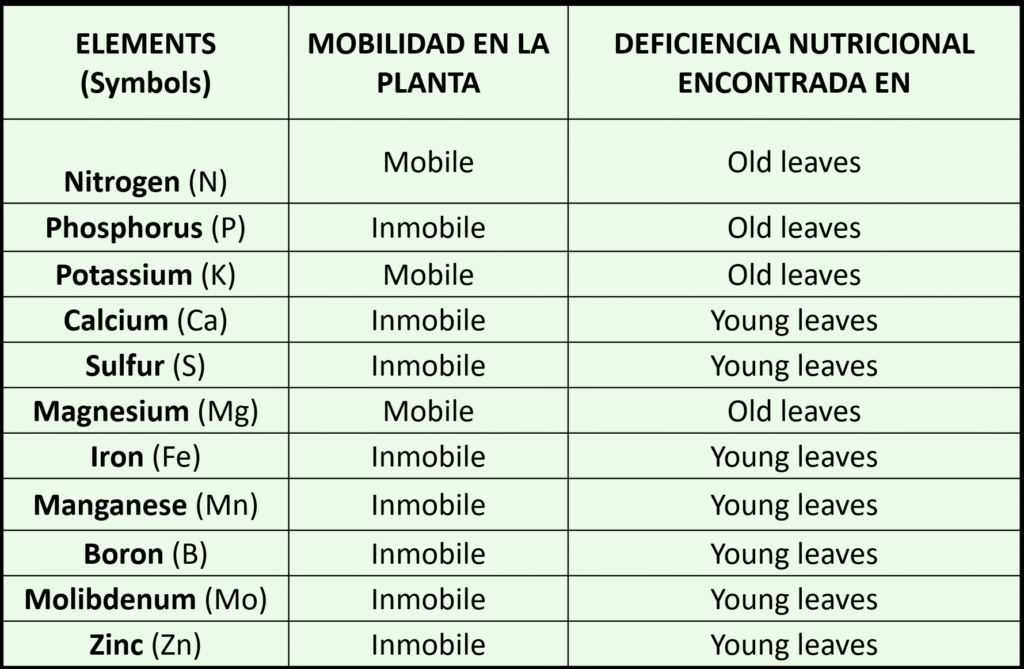
The importance of pH
Soil can contain all the nutrients a plant needs, but it won’t be able to access them if the pH isn’t right. Marijuana plants prefer soil with a pH between 6.0 and 6.5. Anything lower or higher will make it difficult for the roots to absorb key nutrients, resulting in nutrient lockout. This can be avoided by flushing the roots.
Monitor the pH of your irrigation water, especially if you fertilize.



